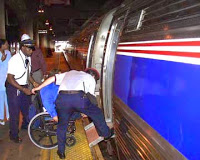 |
| Assisted level boarding on Amtrak's Northeast Corridor |
Today, few commuter rail systems in the United States offer this level of accessibility. The NCTD Sprinter (see video) may be the only one, and is often classified as "light" rail. U.S. systems with level boarding (such as in the Northeast) have a gap of six inches or more between the platform and the train, requiring the use of bridge plates for a wheelchair user to board. As shown in the photo above, train crew members must assist with the process of deploying the bridge plate, monitoring the wheelchair, and re-stowing the bridge plate. Assisted boarding can easily extend station dwell times and cause delays, even on a rail system with level boarding. These delays are allowed for by padding the time between successive trains, to prevent a delay from cascading to multiple trains.
So, just build the platforms close enough to the tracks and we're done, right? It's not quite that easy.
Dynamic Vehicle Envelope
 |
| Dynamic envelope as defined for Caltrain electrification |
- 8" platforms (existing) are 64" from track center
- 25" platforms would have to be 67" from track center
- 30" platforms would have to be 68" from track center
- 50" platforms would have to be 70" from track center
 | |
| Unassisted level boarding in Zurich (Siemens photo) |
These gap-filling steps are quite common outside the confines of U.S. commuter rail, and all major vehicle manufacturers worldwide can provide them if the customer asks. Video examples:
- Vienna, Austria (Stadler)
- Leipzig, Germany (Bombardier)
- Stuttgart, Germany (Alstom / Bombardier)
- San Diego, California (Siemens)
Caltrain's Approach: What Gap?
Caltrain is now taking a "not to preclude" approach to level boarding, attempting to future-proof the new EMU fleet for any future decision regarding level boarding, pending the outcome of additional planning for the Caltrain / high-speed rail blended system. This approach is largely a result of not having seriously thought about or planned for level boarding until quite recently.
As it turns out, Caltrain has no intention to comply with the ADA gap requirement. Never mind the gap. As will be apparent in the upcoming vehicle RFP, the new EMU fleet will comply with the ADA using crew-assisted boarding with bridge plates, even after level boarding platforms are built and regardless of the selected platform height.
If Caltrain fails to specify gap-filling steps and leveling suspensions for their new EMU fleet, then wheelchair users will still need crew assistance to board or alight, resulting in random and unpredictable impacts on station dwell times. Such a failure would preclude reliable and punctual operation of the blended system, increase the amount of timetable padding between trains, and limit the capacity that can be extracted from the peninsula rail corridor before expensive and controversial infrastructure upgrades become unavoidable. Gap-filling steps and leveling suspensions are perfect examples of small off-the-shelf features that pay off in the long run.
In order "not to preclude" an efficient blended system that extracts the highest capacity from limited infrastructure, Caltrain should require that the new EMU fleet be equipped for ADA-compliant unassisted wheelchair boarding, once new level boarding platforms become available. Because the new fleet will be in service until the year 2050, this capability cannot be an afterthought and must be engineered into the new trains from the outset.